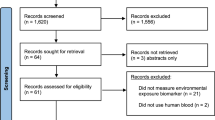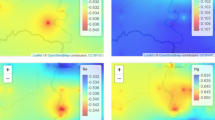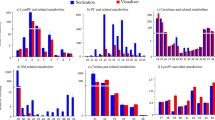Abstract
The exposure of pregnant women and young children to environmental pollutants is an ongoing concern of state and local public health departments. Of primary concern is the exposure to lead in lead-based paints, methyl mercury in contaminated fish and cadmium present at mining sites. The feasibility, utility and methodology of using blood spot cards collected for new born health screening purposes was studied for use in conducting routine state-wide surveillance of blood lead, mercury and cadmium levels in infants. Homogeneity of different lots of blank filter paper was examined. Mass measurements (weights) of filter paper punches were taken across three different lots of filter paper. Statistical analysis of the data was performed using one-way ANOVA, which indicated no significant difference in the means of all three lots, but high variances were noted. The three metals were examined in three different lots of filter papers purchased from the manufacturer. The lots had measurable amounts of cadmium and lead, but not mercury. Lead spike values were observed for roughly about 7% of the blank samples, indicating heterogeneous distribution of this metal. Statistical analysis of the data was also performed using a two-way ANOVA calculation with Tukey's pairwise comparisons. The results found that total mean metal loadings across the three lots were different. The concentration of the metals can be different from each other and the concentration of any one metal can differ across lots. Stability at different concentrations of the heavy metals in blood spotted onto filter paper with time and storage conditions was examined. Results indicate acceptable performance for at least 8.5 months for lead (near CDC's concern level) and for mercury (near NRC's concern level). The filter paper and blood spots were analyzed for metals using an acid extraction, followed by analysis using an inductively coupled plasma mass spectrometer (ICP-MS). Blood spot cards were studied from four different states across the Rocky Mountain region. Internal blank punches adjacent to the blood spot and actual dried spot punches from the same card were analyzed simultaneously. The blank punch indicated the amount of contamination present in the blood spot sample. Statistical analysis of the data was performed using MANOVA followed by calculations for each metal separately. This method was found to be suitable for assessing maternal exposure to lead and mercury using residual newborn screening specimens. Additional research into the applicability for cadmium is needed. Because of the intrinsic problem of contamination from the skin surface of capillary blood samples or other internal or extraneous sources, automatic re-analysis of elevated results assures minimal false positives are reported.
This is a preview of subscription content, access via your institution
Access options
Subscribe to this journal
Receive 6 print issues and online access
$259.00 per year
only $43.17 per issue
Buy this article
- Purchase on Springer Link
- Instant access to full article PDF
Prices may be subject to local taxes which are calculated during checkout









Similar content being viewed by others
References
Agency for Toxic Substances and Disease Registry (ATSDR). Toxicological Profile for Lead (Updated). US Department of Health and Human Services (Public Health Services), Atlanta, Georgia. July 1999a.
Agency for Toxic Substances and Disease Registry (ATSDR). Toxicological Profile for Mercury (Updated). US Department of Health and Human Services (Public Health Services), Atlanta, Georgia. March 1999b.
Centers for Disease Control and Prevention. Third National Report on Human Exposure to Environmental Chemicals. National Center for Environmental Health, Division of Laboratory Sciences, Atlanta, Georgia 30341-3724. NCEH Pub. No. 05-0570, July 2005.
Cizdziel J.V. Determination of lead in blood by laser ablation ICP-TOF-MS analysis of blood spotted and dried on filter paper: a feasibility study. Anal Bioanal Chem 2007: 388: 603–611.
Clinical and Laboratory Standards Institute®. Blood Collection on Filter Paper for Newborn Screening Programs; Approved Standard-Fifth Edition (LA4-A5) 2007: 27 (20).
Martin R.F. General demming regression for estimating systematic bias and its confidence interval in method-comparison studies. Clin Chem 2000: 46 (1): 100–104.
Mei JV., Alexander J.R., Adam B.W., and Hannon W.H. Use of filter paper for the collection and analysis of human whole blood specimens. J Nutr 2001: 131 (5): 1631S–1636S.
O'Broin S. Influence of hematocrit on quantitative analysis of “blood spots” on filter paper. Clin Chem 1993: 39 (6): 1354–1355.
Rice D.C., Schoeny R., and Mahaffey K. Methods and rationale for derivation of a reference dose for methylmercury by the U.S. EPA. Risk Anal 2003: 23 (1): 107–115.
Schober S.E., Sinks T.H., Jones R.L., Bolger P.M., McDowell M., Osterloh J., et al. Blood mercury levels in US children and women of childbearing age, 1999–2000. JAMA 2003: 289 (13): 1667–1674.
Schonfeld D.J., Cullen M.R., Rainey P.M., Berg A.T., Brown D.R., Hogan J.C., et al. Screening for lead poisoning in an urban pediatric clinic using samples obtained by fingerstick. Pediatrics 1994: 94 (2): 174–179.
Stanton N.V., Maney J.M., and Jones R. Evaluation of filter paper blood lead methods: results of a pilot proficiency testing program. Clin Chem 1999: 45 (12): 2229–2235.
Stern A.H., and Smith A.E. As assessment of cord blood:maternal blood methylmercury ratio: implications for risk assessment. Environ Health Perspect 2003: 111 (12): 1465–1470.
Taylor J.K. Quality Assurance of Chemical Measurements. Lewis Publishers, New York, NY, 1987.
Vereby K., Rosen J.F., Schonfeld D.J., Carrio D., Yee M.E., Deutsch J., et al. Blood collection and analytical considerations in blood lead screening in children. Clin Chem 1995: 41 (3): 469–470.
Wang S.T., and Demshar H.P. Determination of blood lead in dried blood-spot specimens by Zeeman-effect background corrected atomic absorption spectrometry. Analyst 1992: 117: 959–961.
Wong Y.W., Ashwood W.G., and Ash O. ICP-MS quantitation of lead in blood collected on paper. Clin Chem 1995: 41 (6): S145.
Yee H.J., and Holtrop T.G. An improved capillary blood–filter paper–graphite furnace atomic absorption spectrometric method for lead screening. J Anal Tox 1997: 21: 142–148.
Acknowledgements
We thank the Rocky Mountain Biomonitoring Consortium (RMBC) and newborn screening staff from Utah for technical guidance and support for this project. Thanks are due to the states of New Mexico, Montana and Wyoming for providing newborn blood samples. We specially acknowledge Dr. Zheng Yang of the Minnesota Department of Health for consultation with mercury analysis for this work. The statistical analyses performed and consultation provided by Dr. H. Dennis Tolley of the Department of Statistics, Brigham Young University, Provo, Utah, and Dr. Han Kim of the Department of Preventive Medicine, University of Utah, Salt Lake City, Utah, are much appreciated. The support and encouragement from Dr. Patrick F. Luedtke, Director of the Utah Public Health Laboratory, is appreciated. We also thank Dr. Robert Jones of the CDC for review and critique of the initial manuscript. Special thanks are also given to Hannah J. Wilkowske, Merril R. Chipman, Karen Keller and Larry P. Scanlan for all their extra hard work in this work. We would also like to thank the reviewers of the Journal of Exposure Science and Environmental Epidemiology for their work in reviewing this paper and providing exceptionally valuable feedback. It is felt that much was learned because of their comments and input. Finally, thanks are due to U.S. Centers for Disease Control and Prevention for funding the Rocky Mountain Biomonitoring Consortium, Utah Chemical Terrorism and Environmental Public Health Tracking Grant, who funded this study.
Author information
Authors and Affiliations
Consortia
Corresponding authors
Rights and permissions
About this article
Cite this article
Chaudhuri, S., Butala, S., Ball, R. et al. Pilot study for utilization of dried blood spots for screening of lead, mercury and cadmium in newborns. J Expo Sci Environ Epidemiol 19, 298–316 (2009). https://doi.org/10.1038/jes.2008.19
Received:
Accepted:
Published:
Issue Date:
DOI: https://doi.org/10.1038/jes.2008.19
Keywords
This article is cited by
-
A state-of-the-science review and guide for measuring environmental exposure biomarkers in dried blood spots
Journal of Exposure Science & Environmental Epidemiology (2023)
-
Mercury in Neotropical birds: a synthesis and prospectus on 13 years of exposure data
Ecotoxicology (2023)
-
Mercury biomonitoring in German adults using volumetric absorptive microsampling
Environmental Monitoring and Assessment (2022)
-
Implementation of mercury biomonitoring in German adults using dried blood spot sampling in combination with direct mercury analysis
Environmental Monitoring and Assessment (2021)
-
Biomarkers for nutrient intake with focus on alternative sampling techniques
Genes & Nutrition (2016)



